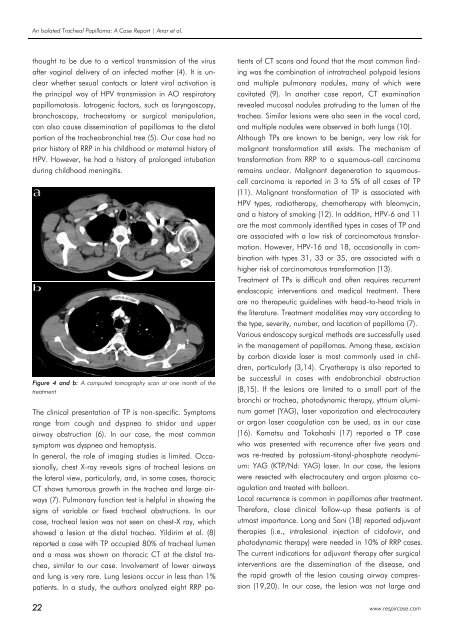Respircase Cilt: 6 - Sayı: 1 Yıl: 2017
You also want an ePaper? Increase the reach of your titles
YUMPU automatically turns print PDFs into web optimized ePapers that Google loves.
An Isolated Tracheal Papilloma: A Case Report | Anar et al.<br />
thought to be due to a vertical transmission of the virus<br />
after vaginal delivery of an infected mother (4). It is unclear<br />
whether sexual contacts or latent viral activation is<br />
the principal way of HPV transmission in AO respiratory<br />
papillomatosis. Iatrogenic factors, such as laryngoscopy,<br />
bronchoscopy, tracheostomy or surgical manipulation,<br />
can also cause dissemination of papillomas to the distal<br />
portion of the tracheobronchial tree (5). Our case had no<br />
prior history of RRP in his childhood or maternal history of<br />
HPV. However, he had a history of prolonged intubation<br />
during childhood meningitis.<br />
Figure 4 and b: A computed tomography scan at one month of the<br />
treatment<br />
The clinical presentation of TP is non-specific. Symptoms<br />
range from cough and dyspnea to stridor and upper<br />
airway obstruction (6). In our case, the most common<br />
symptom was dyspnea and hemoptysis.<br />
In general, the role of imaging studies is limited. Occasionally,<br />
chest X-ray reveals signs of tracheal lesions on<br />
the lateral view, particularly, and, in some cases, thoracic<br />
CT shows tumorous growth in the trachea and large airways<br />
(7). Pulmonary function test is helpful in showing the<br />
signs of variable or fixed tracheal obstructions. In our<br />
case, tracheal lesion was not seen on chest-X ray, which<br />
showed a lesion at the distal trachea. Yildirim et al. (8)<br />
reported a case with TP occupied 80% of tracheal lumen<br />
and a mass was shown on thoracic CT at the distal trachea,<br />
similar to our case. Involvement of lower airways<br />
and lung is very rare. Lung lesions occur in less than 1%<br />
patients. In a study, the authors analyzed eight RRP patients<br />
of CT scans and found that the most common finding<br />
was the combination of intratracheal polypoid lesions<br />
and multiple pulmonary nodules, many of which were<br />
cavitated (9). In another case report, CT examination<br />
revealed mucosal nodules protruding to the lumen of the<br />
trachea. Similar lesions were also seen in the vocal cord,<br />
and multiple nodules were observed in both lungs (10).<br />
Although TPs are known to be benign, very low risk for<br />
malignant transformation still exists. The mechanism of<br />
transformation from RRP to a squamous-cell carcinoma<br />
remains unclear. Malignant degeneration to squamouscell<br />
carcinoma is reported in 3 to 5% of all cases of TP<br />
(11). Malignant transformation of TP is associated with<br />
HPV types, radiotherapy, chemotherapy with bleomycin,<br />
and a history of smoking (12). In addition, HPV-6 and 11<br />
are the most commonly identified types in cases of TP and<br />
are associated with a low risk of carcinomatous transformation.<br />
However, HPV-16 and 18, occasionally in combination<br />
with types 31, 33 or 35, are associated with a<br />
higher risk of carcinomatous transformation (13).<br />
Treatment of TPs is difficult and often requires recurrent<br />
endoscopic interventions and medical treatment. There<br />
are no therapeutic guidelines with head-to-head trials in<br />
the literature. Treatment modalities may vary according to<br />
the type, severity, number, and location of papilloma (7).<br />
Various endoscopy surgical methods are successfully used<br />
in the management of papillomas. Among these, excision<br />
by carbon dioxide laser is most commonly used in children,<br />
particularly (3,14). Cryotherapy is also reported to<br />
be successful in cases with endobronchial obstruction<br />
(8,15). If the lesions are limited to a small part of the<br />
bronchi or trachea, photodynamic therapy, yttrium aluminum<br />
garnet (YAG), laser vaporization and electrocautery<br />
or argon laser coagulation can be used, as in our case<br />
(16). Kamatsu and Takahashi (17) reported a TP case<br />
who was presented with recurrence after five years and<br />
was re-treated by potassium-titanyl-phosphate neodymium:<br />
YAG (KTP/Nd: YAG) laser. In our case, the lesions<br />
were resected with electrocautery and argon plasma coagulation<br />
and treated with balloon.<br />
Local recurrence is common in papillomas after treatment.<br />
Therefore, close clinical follow-up these patients is of<br />
utmost importance. Long and Sani (18) reported adjuvant<br />
therapies (i.e., intralesional injection of cidofovir, and<br />
photodynamic therapy) were needed in 10% of RRP cases.<br />
The current indications for adjuvant therapy after surgical<br />
interventions are the dissemination of the disease, and<br />
the rapid growth of the lesion causing airway compression<br />
(19,20). In our case, the lesion was not large and<br />
22 www.respircase.com

















